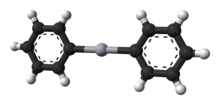Diphenylmercury
Appearance

| |

| |
| Identifiers | |
|---|---|
| ECHA InfoCard | 100.008.734 |
CompTox Dashboard (EPA)
|
|
| Properties | |
| C12H10Hg | |
| Molar mass | 354.80 g mol−1 |
| Density | 2.318 g cm−3[1] |
| Boiling point | 204 °C[1] |
| slightly soluble in ethanol, diethyl ether; soluble in benzene, chloroform[1] | |
Except where otherwise noted, data are given for materials in their standard state (at 25 °C [77 °F], 100 kPa).
| |
Diphenylmercury is a colourless, crystalline[2] organomercury compound with the chemical formula C12H10Hg. It can be synthesised by the reaction of a 2:1 molar ratio of mercury(II) chloride and methyltriphenyltin in ethanol.[2] As with almost all organomercury compounds, the coordination geometry at mercury is linear.[2]
References
- ^ a b c Lide, David R. (2008). CRC Handbook of Chemistry and Physics, 89th Edition. CRC Press. p. 3–518. ISBN 978-0849304880.
- ^ a b c C. Glidewell, J. N. Low, J. L. Wardell (2005). "Diphenylmercury, redetermined at 120 K: sheets built from a single C-H…π(arene) hydrogen bond". Acta Cryst. C61 (Pt 2): m107–m108. doi:10.1107/S0108270104034134. PMID 15695887.
{{cite journal}}: CS1 maint: multiple names: authors list (link)
